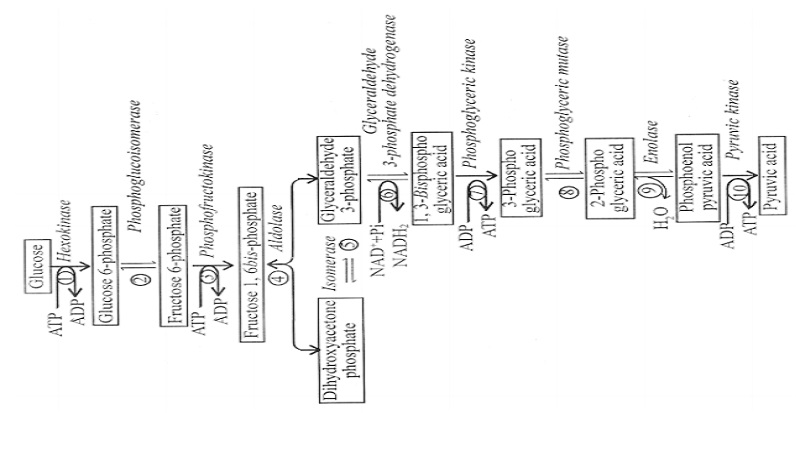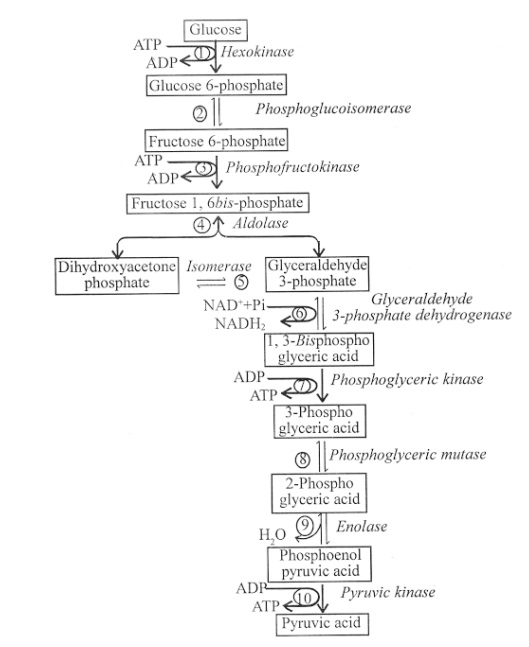Chapter: 11 th 12th std standard Bio Botany plant tree Biology Higher secondary school College Notes
Plant Respiration : Glycolysis

Mechanism of respiration
Oxidation of glucose involves following four distinct stages - glycolysis, oxidative decarboxylation of pyruvic acid, Krebs cycle and Electron transport chain. In the first three stages, the hydrogen acceptor Nicotinamide adenine dinucleotide - oxidized form (NAD+) and Flavin adenine dinucleotide - oxidized form (FAD+) are reduced to NADH2 and FADH2 respectively. Both the coenzymes, (NAD+) and (FAD+) act as hydrogen carriers from respiratory substrate to electron transport chain, where H+ and electrons are transferred to oxygen to form water. This electron transport results in the release of energy, which is used to phosphorylate ADP to ATP. Hence, the electron transport chain reactions are referred to as oxidative phosphorylation.
Glycolysis
The process by which the glucose (6C compound) is split into two molecules of pyruvic acid (3C compound) is called glycolysis. Three German Microbiologists ' Embden, Meyerhof and Parnas, first demonstrated this process in yeast cell. Hence, it is otherwise known as EMP pathway. It occurs in cytoplasm. It is common in all organisms. It is divided into two phases ' hexose phase and triose phase. Glyceraldehyde 3-phosphate and DHAP are the products of hexose phase and two molecules of pyruvic acid are the products of triose phase. The overall reaction of glycolysis is given in the following equation.
Reactions involved in glycolysis are as follows
1. The glucose is phosphorylated with ATP to form glucose-6-phosphate. The reaction is catalyzed by the enzyme hexokinase.
2. Glucose-6-phosphate is isomerized to form fructose-6-phosphate by phosphoglucoisomerase.
3. Fructose-6-phosphate is then phosphorylated using ATP to form fructose 1,6-bisphosphate. This reaction is catalyzed by phosphofructokinase. The ATP is dephosphorylated to ADP.
4. Fructose 1,6-bisphosphate is cleaved by the enzyme aldolase to two molecules of 3C compounds - dihydroxy acetone phosphate (DHAP) and glyceraldehyde 3-phosphate. These two trioses are isomers.
5. DHAP and glyceraldehyde-3-phosphate are interconvertible by the action of triose phosphate isomerase. These five series of reaction constitute hexose phase and produce two molecules of 3-carbon compound called 3-phosphoglyceraldehyde. In hexose phase two ATP molecules are consumed.
6. A molecule of glyceraldehyde-3-phosphate is phosphorylated and oxidized to 1,3-bisphosphoglyceric acid in the presence of glyceraldehyde-3-phosphate dehydrogenase. During this reaction, one NADH2 is formed.

7. 1,3-bisphosphoglyceric acid is dephosphorylated to a molecule of 3-phosphoglyceric acid by phosphoglyceric kinase. During this reaction one ATP is formed. This type of ATP synthesis is called direct phosphorylation or substrate level phosphorylation.
8. A molecule of 3-phosphoglyceric acid is then converted into a molecule of 2-phosphoglyceric acid by phosphoglyceric mutase. In this reaction, phosphate molecule is shifted form third carbon to second carbon.
9. A molecule of 2-phosphoglyceric acid is dehydrated to a molecule of 2-phosphoenol pyruvic acid by enolase. Removal of water molecule from the substrate is called enolation.
10. A molecule of 2-phosphoenol pyruvic acid is dephosphorylated to pyruvic acid and ADP is phosphorylated to ATP. This reaction is catalyzed by pyruvic kinase. Thus, in the triose phase, two molecules of a molecule of 3-phospho glyceraldehyde produce 2 molecules of pyruvic acid.
In glycolysis, 4ATP and 2NADH2 molecules are formed and 2ATP molecules are consumed in hexose phase. Hence, the net gain is 2ATP and 2NADH2.
Oxidative decarboxylation of pyruvic acid
The two molecules of pyruvic acid formed from a glucose molecule move into mitochondria and are oxidized, decarboxylated to two molecules of acetyl coenzyme A (acetyl Co~A). These 2 carbon compounds are formed by
This reaction is catalyzed by pyruvic dehydrogenase and two molecules of NAD+ are reduced to NADH2. During this reaction two molecules of CO2 are released. Oxidative decarboxylation of pyruvic acid occurs only under aerobic condition. Under anaerobic conditions, the pyruvic acid is reduced either to lactic acid or ethyl alcohol depending on the nature of the organism.
Related Topics